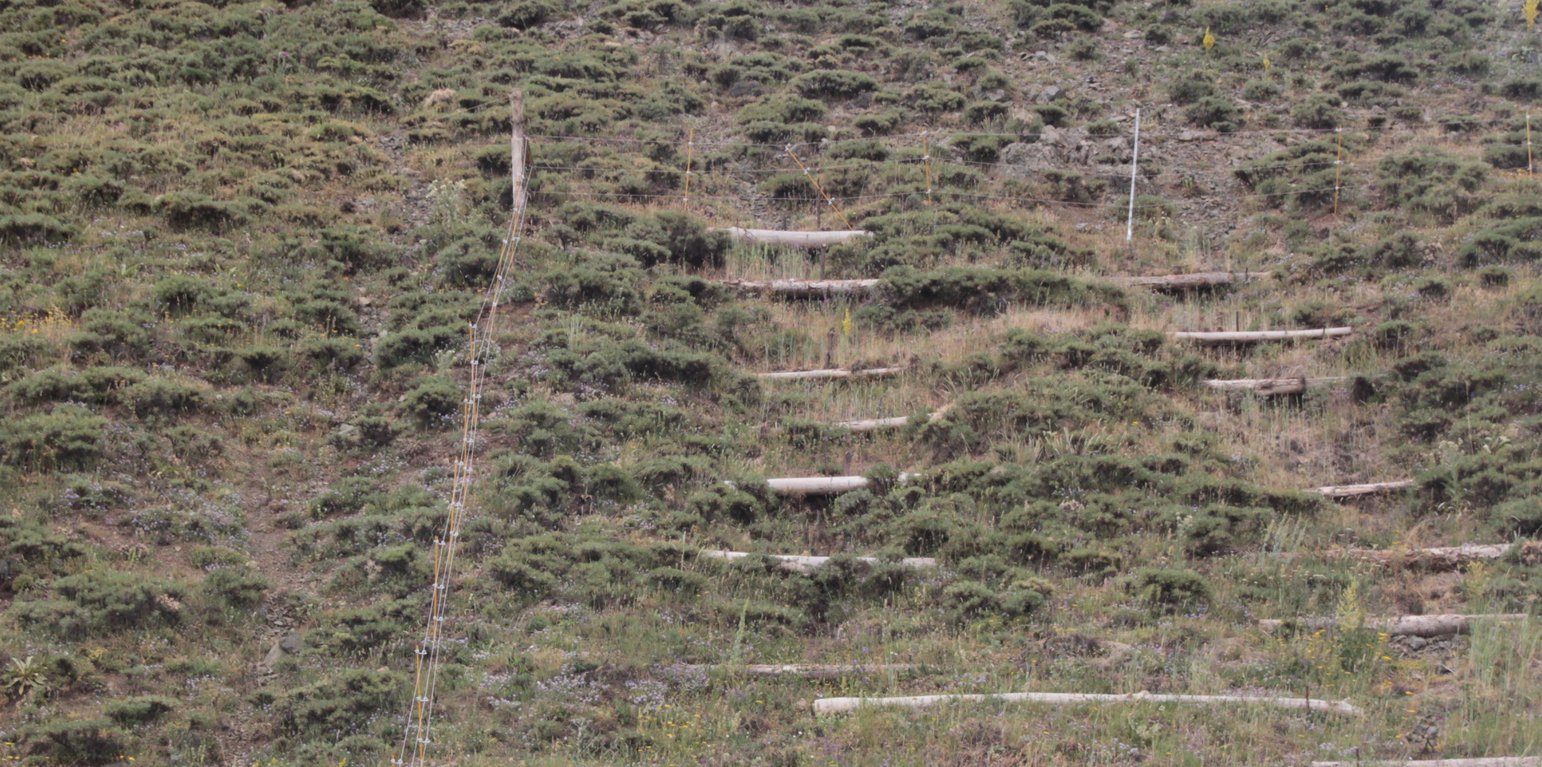



In the provinces of Aragatsotn and Shirak in Armenia, the weather is cold and temperate with dry summer. Steep slopes, pastures and some autochthonous oak forests make up the area. Farmers make most of their income with grazing by manual labour. The carrying capacity of pastures in the vicinity is regularly exceeded, and they degrade more and more. In order to stabilize the steep eroded slopes, pile walls were established. Pile walls are horizontal constructions along a slope, functioning as erosion control measures by slowing down the superficial water runoff, retaining materials and supporting the rehabilitation of vegetation.
The major advantages are: It is not expensive since mostly locally available materials can be used, and a positive effect can already be observed within a year. Also, the pile walls can be established relatively easy without any need of heavy machinery or specific knowledge and, therefore, allow the involvement of the local population.
In the case of the implementation in Armenia, the exact location for the pilot measures was selected in such a way that grazing activities were almost not impaired. For temporary exclusion of livestock, electric fencing was used. Within the fenced area, pile walls were established in the washed-out rills along the slope to address the water erosion phenomena.
The technical requirements and workload for the construction of a pile wall are relatively low. The needed resources require iron piles, a hammer, wooden logs (or a bundle of branches) and tree cuttings. First, the wooden logs were cut in 1-2 m length to fit into the irregular rills of the slope. After identifying the locations of individual pile walls, the team fixed the logs with iron poles of about 70-100cm length. The distance between the pile walls varies between 1-3m, depending on the topography: the steeper the slope, the closer the distance. The space behind the logs was filled with soil, plant material and rocks to stabilize the construction and to reduce the risk of water washing out the soil and passing below the logs. As a last step, the terraces were covered with hay to provide protection against precipitation and to accelerate re-growth of grass through the seeds contained in the hay residuals.
Community members were surprised how easy and quick the pile walls could be established. A team of two workers established a pile wall within 30 min. Since these areas are usually intensively used and thus are of high importance for the community, even a temporary exclusion from use must be thoroughly discussed and agreed upon.
The measure slows down vertical water-run off and provides steps for cattle. Due to temporary fencing and the application of hay mulch vegetation is recovering on these parts.
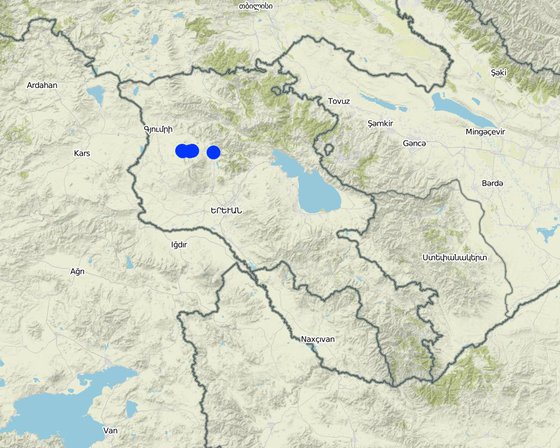
Location: Lusagyugyh, Hnaberd, Ghegadhzor, Saralandj, Mets Mantash, Aragatsotn and Shirak Marzes (Provinces), Armenia
No. of Technology sites analysed: 2-10 sites
Spread of the Technology: evenly spread over an area (approx. < 0.1 km2 (10 ha))
Date of implementation: less than 10 years ago (recently)
Type of introduction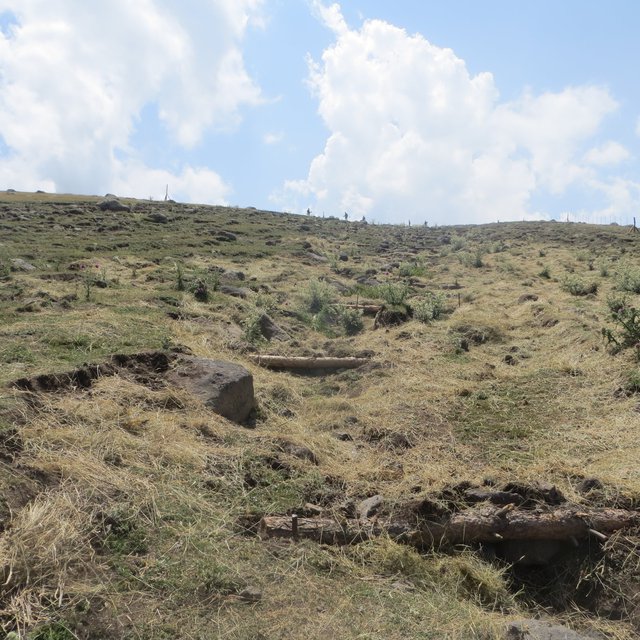
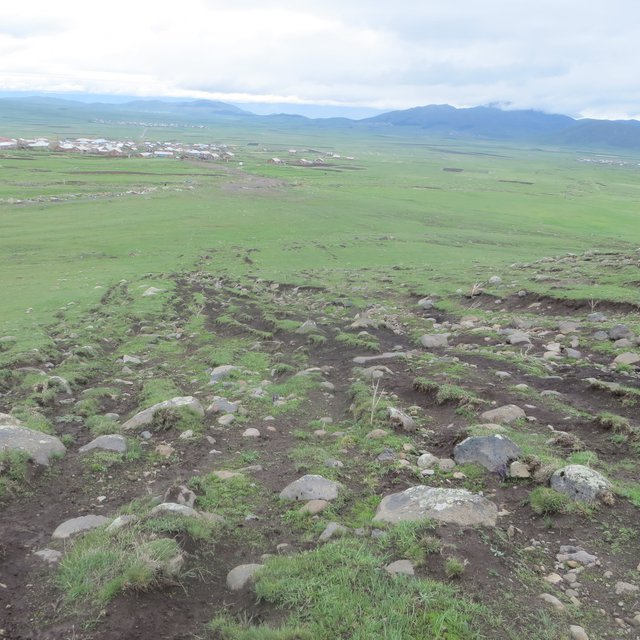







Technical specifications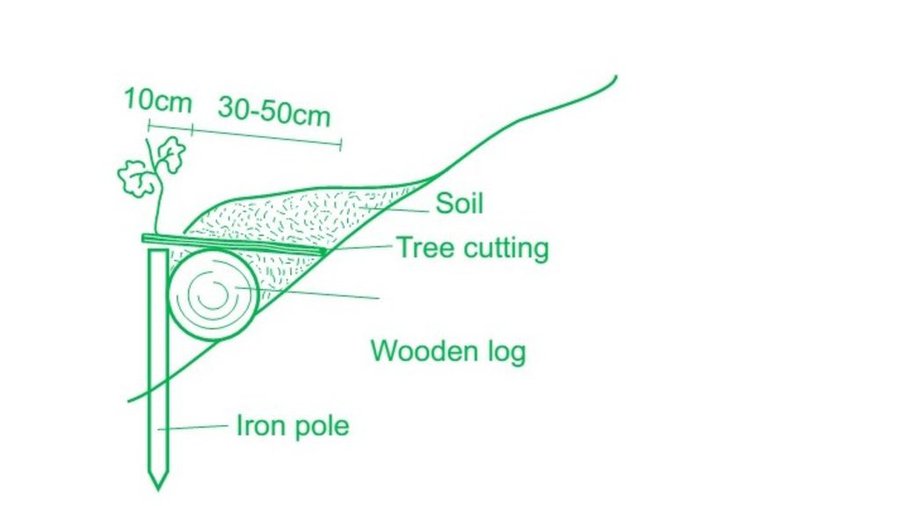
Author: GIZ IBiS
Required materials for 1 pile wall:
- 2 iron poles (0.7-1m) and a hammer - 1 wooden log (ca. 4 m, 20-25cm diameter) - 10-20 shrub cuttings (e.g. Salix species) Selection of appropriate sites for pile walls (where and how to put them): The logs are being spread on the slope as indictated in the scheme of the figure. The steeper the slope the narrower the vertical spacing in between (max. 4m, min. 1-2 m). On uneven slopes, place the along the depressions as these are the areas where water-run off is strongest. Parts which show no erosion signs can be left out to not destroy existing vegetation cover. The location of the pile walls is determined by the slope and serves to stabilize the slope at superficial level (10-30 cm). It landslides occur that involve deeper soil layers, this technology is not efficient. Building process: After placing the logs, those are fixed with two irons at the end (alternatively wooden posts can be used as well). After fixing the logs, the space behind needs to be filled (slight terracing of the slope). Additionally, either shrub seedlings or living cuttings from species such as willows (ca. 50cm long, 2-5cm diameter) should be integrated. Finally, the open soil should be covered by a layer of 2-5 cm of hay/grass containing seeds and eventually additional seeds (from local species) to promote the re-establishment of vegetation. This has also the benefit that this cover keep humidity in the soil, which is particularly important in (semi-)arid areas. Species used/density: At least 20 cuttings per pile wall should be planted. Depending on the survival rates, it can be also more. Shrubs additionally stabilize the slope and are to some extent protected by the pile wall. |
|||||||||||
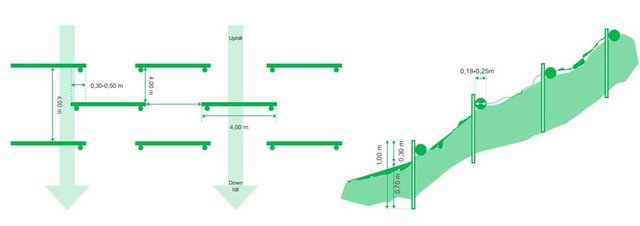
Author: GIZ IBiS
|
|||||||||||
| Specify input | Unit | Quantity | Costs per Unit (US Dollars) | Total costs per input (US Dollars) | % of costs borne by land users |
| Labour | |||||
| Unskilled worker: Implementation of field measures | person days | 30.0 | 21.0 | 630.0 | 10.0 |
| Skilled expert (Implementation supervision and project management | person days | 14.0 | 120.0 | 1680.0 | |
| Transportation costs (truck, experts) | rental days | 12.0 | 54.0 | 648.0 | 10.0 |
| Administration costs | month | 1.0 | 127.0 | 127.0 | |
| Equipment | |||||
| Consumables | set | 1.0 | 59.0 | 59.0 | 10.0 |
| Electric tools | set | 1.0 | 424.0 | 424.0 | 10.0 |
| P3800 Fence energizer + Box and equipment | set | 1.0 | 345.0 | 345.0 | |
| Solar Panel for fence energizer | piece | 1.0 | 233.0 | 233.0 | |
| Battery and fence tester | piece | 1.0 | 203.0 | 203.0 | |
| Plant material | |||||
| Cuttings (20 per pile wall) (not used as it is being grazed) | pieces | ||||
| Hay/grass for mulch cover (Bales ca.20kg) | kg | 800.0 | 0.08 | 64.0 | |
| Construction material | |||||
| Wooden logs (3m, 20cm diameter) | pieces | 50.0 | 17.0 | 850.0 | |
| Iron poles (0.7-1m, 10 mm diameter) | pieces | 150.0 | 2.1 | 315.0 | |
| Electric Fence Polywire | m | 1300.0 | 0.3 | 390.0 | |
| Electric Fence Corner donut insulator | pieces | 27.0 | 1.0 | 27.0 | |
| Earth stakes | pieces | 3.0 | 22.0 | 66.0 | |
| Electric Fence Spring Gate Set | piece | 1.0 | 42.0 | 42.0 | |
| Wooden Posts | pieces | 9.0 | 6.4 | 57.6 | 20.0 |
| Total costs for establishment of the Technology | 6'160.6 | ||||
| Specify input | Unit | Quantity | Costs per Unit (US Dollars) | Total costs per input (US Dollars) | % of costs borne by land users |
| Labour | |||||
| Regular check of fence | workdays | 8.0 | 21.0 | 168.0 | 100.0 |
| Installation and deinstallation of electric fence | workdays | 8.0 | 21.0 | 168.0 | 100.0 |
| Changing the broken posts | workdays | 1.0 | 21.0 | 21.0 | 100.0 |
| Optional refill of stones and/or soil if washed out | workdays | 3.0 | 21.0 | 63.0 | 100.0 |
| Total costs for maintenance of the Technology | 420.0 | ||||
The erosion control masures stopped top soil Erosion and Gully Erosion in the pasture land.
The workload for implementing the measures does not pay off within the first view years but is a long term investment in saving soil productivity.
The intervention raised awareness to soil erosion and new technologies have been trained to village stakeholders (pile walls, electric fencing)
Water run off is decreased and soil moister is increase by better infiltration of water into the soil.
The increase of vegetation leads to an increase of evaporation-transpiration.
Water run off is decreased by pile walls and better vegetation cover and soil moister is increase by better infiltration of water into the soil.
Decrease of water run off by pile walls and increased vegetation cover leads to decrease of soil loss.
Increase of vegetation leads to more root activity and humus increase by increase of litter.
The stop of grazing and trampling by the fence leads to fast increase of vegetation cover.
The stop of grazing leads to significant increase of above ground biomass.
On heavily eroded sites the measure lead to increase of plant species.
The increase of above soil biomass increase the risk of grass-fire in autumn during or after the dry season.
through increased vegetation cover and reduced speed of superficial water-runoff and increase of water capacity of the slope above the village.
partially improved through increased vegetation cover and less open soil